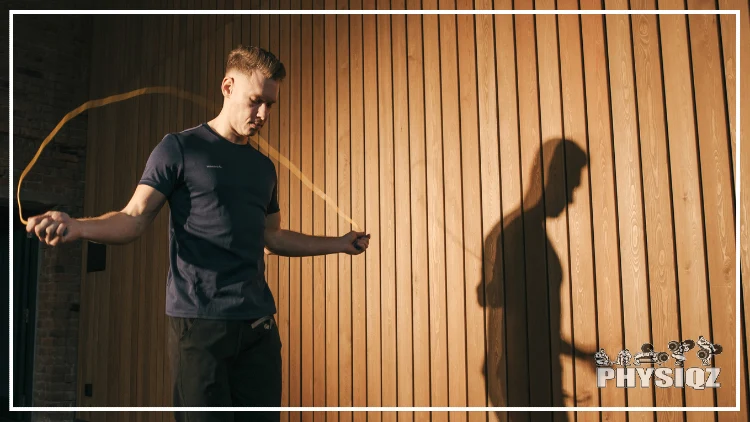
Understanding the muscles targeted by jump rope, its benefits, and its effectiveness as a form of cardio is essential for those considering adding this schoolyard exercise to their routine.1 It’s important to grasp these aspects before “jumping” straight into things.
That being said, the information below covers everything you need to know about jump roping such as:
- Before and after jump rope pictures in comparison to my results
- Every muscle worked
- The countless benefits
- Whether or not jump roping is good for losing weight, muscle building and cardio
- A full list of variations to try
What Muscles Work When During a Jump Rope?
Many jumpers wonder what muscles work during jump rope as the complex dynamic movement of jumping will engage multiple body parts at once. And well, the answer is many different muscles such as the:
- Glutes
- Thighs
- Hamstrings
- Core
- Biceps
- Forearms
- Back
- Shoulders
- And even the chest!
Even though these are most of the muscle groups worked, there’s many more muscles within each group so below we’ll depict each, it’s function, and where it’s located.
The Butt or Glute Muscles (Gluteus Maximus, Medius, & Minimus)
When it comes to the muscles that work during jump rope, perhaps the most targeted muscle is the three muscles that form the buttocks. This is the gluteus maximus, gluteus medius, and gluteus minimus, but are more commonly referred to as the glutes.
Maximus
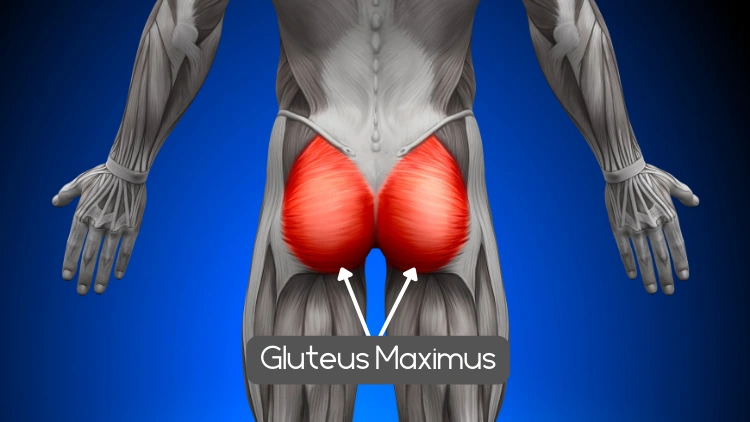
Source: decade3d via Canva.com2
Medius
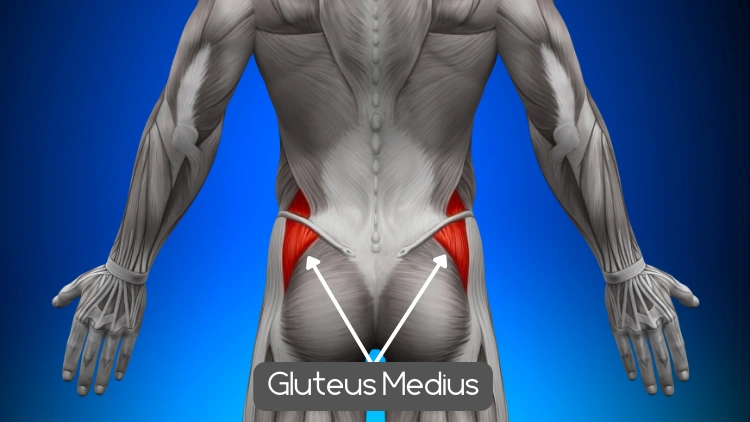
Source: decade3d via Canva.com3
Minimus
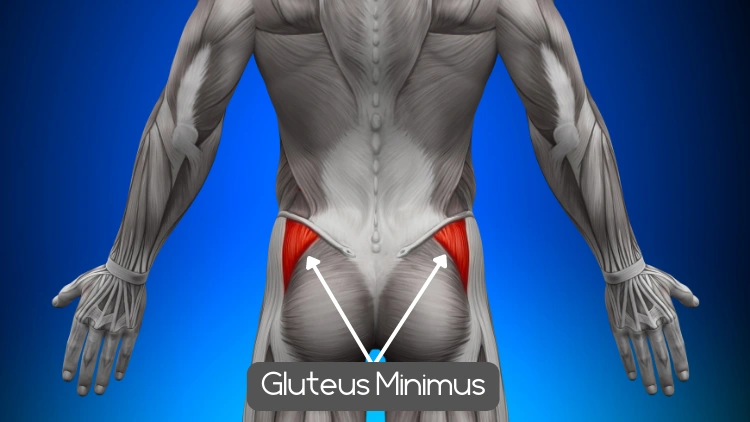
Source: decade3d via Canva.com3
The Frontside Thigh Muscle or Quads (Quadriceps)
In addition to jump rope targeting the glutes, the quadriceps or “quads” are also engaged to complete that jumping motion. Specifically this muscle is engaged when the knee is straight or in extension.
Quadriceps

Source: janulla via Canva.com4
The Backside Thigh Muscle or Hammies (Hamstrings)
The hamstrings are commonly known as the hammies and are found on the posterior (back side) side of the upper leg. These muscles are responsible for knee flexion, which is a movement repeatedly completed during jump rope.
For those aiming to thoroughly build hamstring and glute size, incorporating a back squats program or a deadlift workout into their routine is highly recommended. This will help to really maximize muscle building and can be easy to add to a jump rope program.
Hamstrings
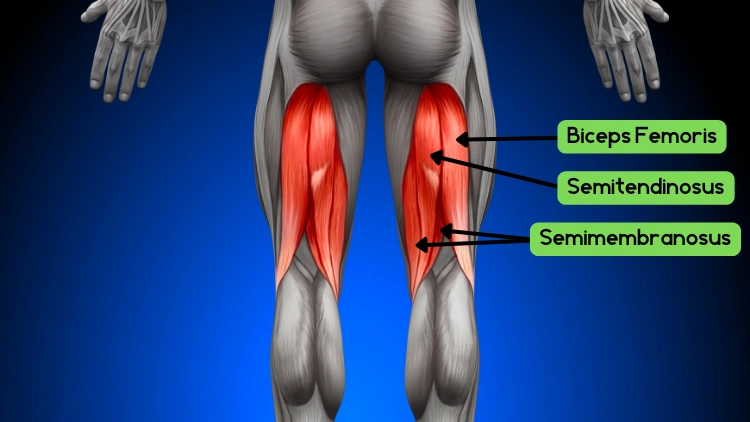
Source: decade3d via Canva.com5
The Core or Abs (Abdominals)
During jump rope, the core should be tight to maintain an upright position during all that dynamic movement.
Therefore jumping rope will really engage the abs. Because jumping rope can also lead to fat loss, the abs might become more visible through consistent use of this exercise.
Abdominals
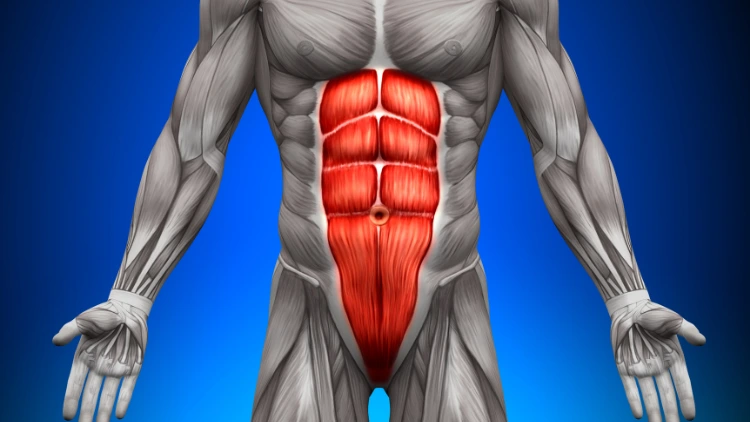
Source: decade3d via Canva.com6
The Calves (Gastrocnemius & Soleus)
Jumpers might find themselves wondering if jumping rope build calves. It’s a valid question, especially since the calves are among the hardest muscles to grow.
Luckily, jumping rope is a great way to target the lower leg to help build muscle size and strength. This is done by targeting gastrocnemius and soleus, which are the two different muscles that comprise what is commonly referred to as the calves.
The calf muscles are constantly activated thanks to the landing and jumping motion that requires ankle flexion and extension. Research has found that the calves are much more engaged during a bounced jump technique, so try this strategy if building the calf muscles is the goal.7
Gastrocnemius
Soleus
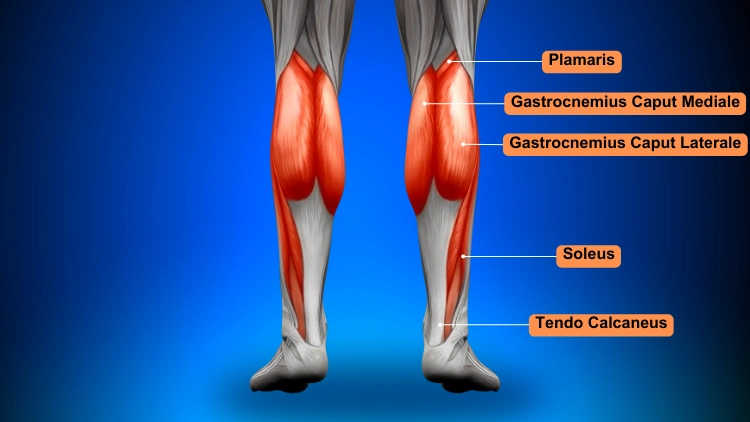
Source: decade3d via Canva.com8
The Upper Arm Muscles or Bis & Tris (Biceps & Triceps)
Many people think of jump rope as a lower body exercise, but the arms must also be engaged to do this movement. Specially the biceps and triceps are required due to the flexion and extension of the elbow respectively.
This movement is required to help propel the jump rope around the body.
Jumpers wanting to specifically target the upper body, especially the arm and shoulders, should check out battle rope before and after results. This equipment is specifically designed to engage and build the upper body, and come highly recommended from powerlifters and bodybuilders alike. When using battle ropes, the muscles worked also include the lower body.
Biceps
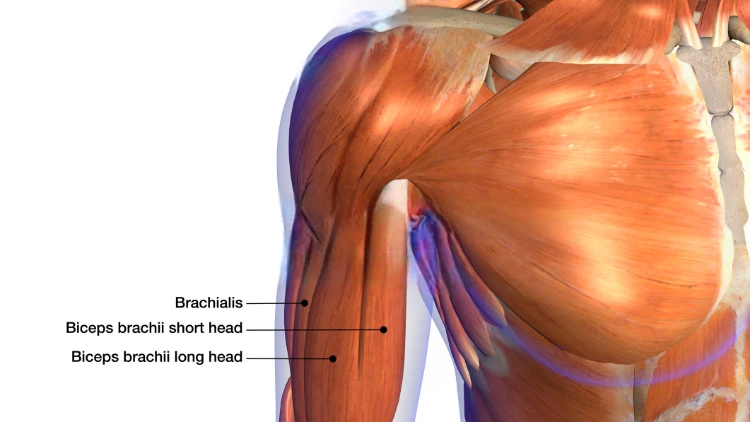
Source: Hank Grebe via Canva.com9
Triceps
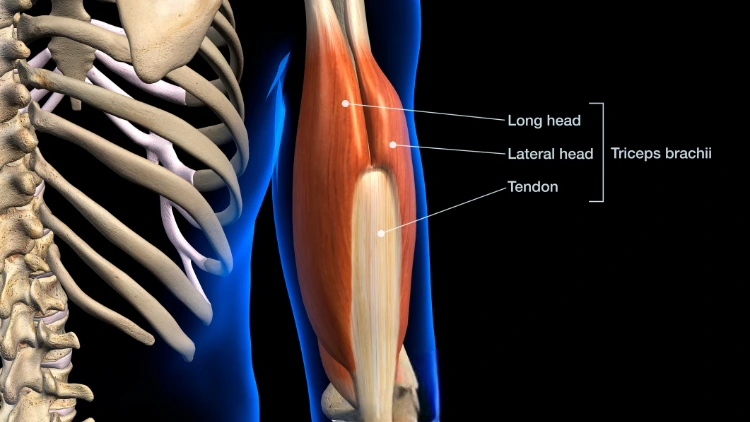
Source: Hank Grebe via Canva.com10
The Shoulder Muscles (Deltoids)
In addition to working the arms, the deltoids will also be engaged during a jump rope workout. This is due to the slight rotational movement of the shoulder muscle that is required to spin the jump rope (works the anterior deltoids), as well as the slight shoulder flexion and abduction or movement away from the body (works the lateral and posterior deltoids).
Delts
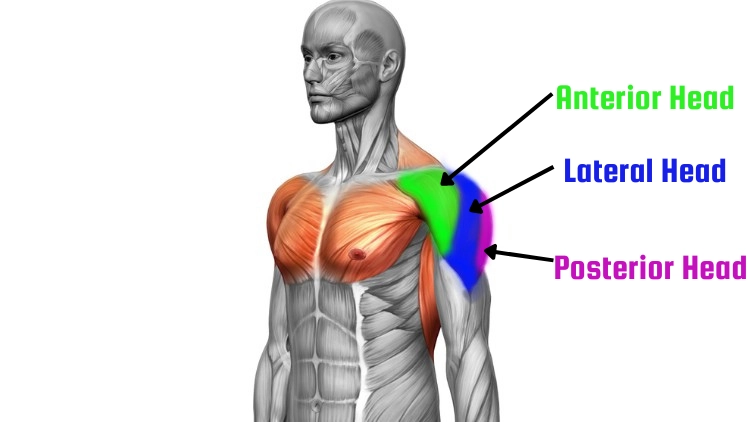
Source: Science Photo Library via Canva.com11
The Rotator Cuff (Supraspinatus, Infraspinatus, Teres Minor, & Subscapularis)
The rotator cuff consists of four muscles that stabilize the arm during jump roping. They will also assist with arm abduction and scapular rotation during forward and backward jump rope movements. These muscles can be found on the front side and back side of the scapula, more widely known as the shoulder blade.
Supraspinatus
Infraspinatus
Teres Minor
Subscapularis
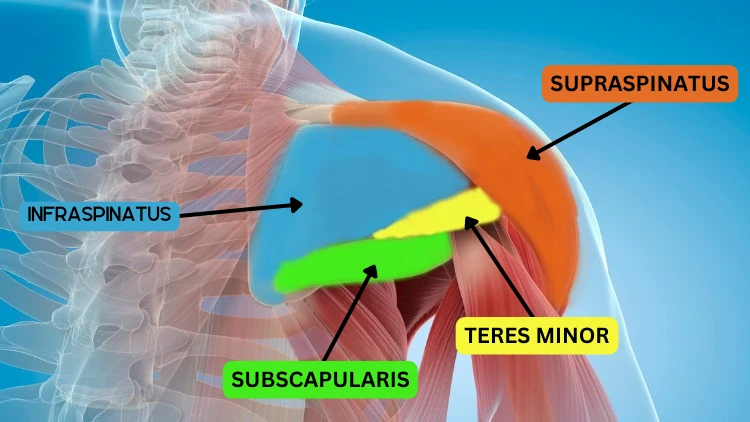
Source: Science Photo Library via Canva.com12
The Forearm Muscles
Because the wrists engage in flexion and extension during jump rope, various muscles of the forearm will also be engaged. This includes the flexor digitorum profundus and superficialis, which are a part of the palm side of the forearm and commonly referred to as the forearm flexors.
Additionally the extensor digitorum is engaged during wrist and finger extension, which is referred to as the forearm extensor muscle and found on the back side of the lower arm.
Extensor Digitorum or Forearm Extensor
Flexor Digitorum Profundus or Forearm Flexor
Flexor Digitorum Superficialis or Forearm Flexor
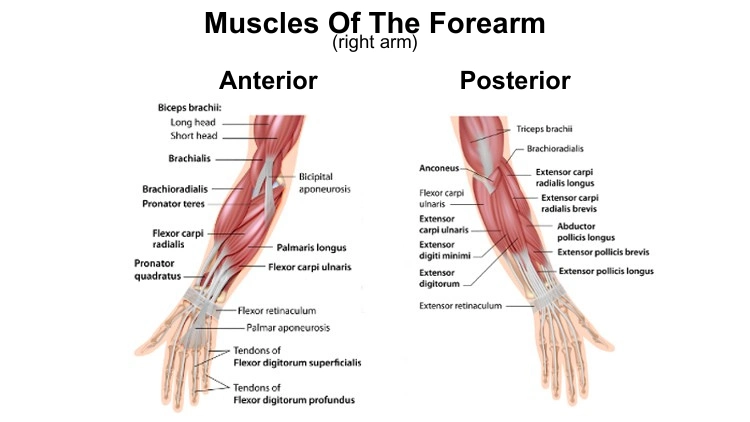
Source: Alila Medical Media via Canva.com13
The Back Muscles or the Lats & Traps (The Latissimus Dorsi & Trapezius)
Similar to the abdominals, jumping rope engages the back muscles by requiring the body to maintain an upright position. This requires the back muscles to be engaged such as the commonly worked lats and traps, as well as the deeper erector muscles of the spine.
Lats
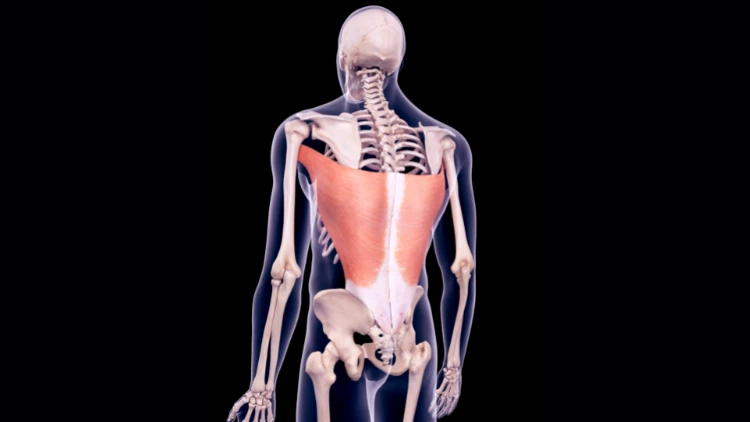
Source: Science Photo Library via Canva.com14
Traps
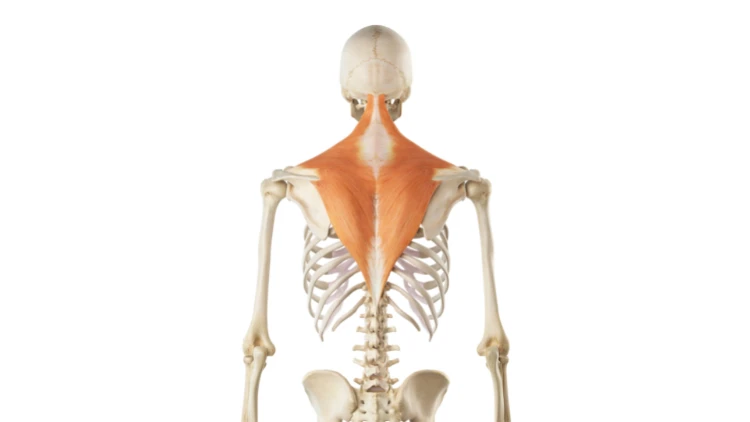
Source: Science Photo Library via Canva.com15
The Chest Muscles or Pecs (The Pectorals)
Finally, the pecs will also be engaged during jump rope.
Something else others may not know is that these are actually two muscles called the pectoralis major and minor, and are found in the chest area.
These muscles are considered to be targeted due to the slight shoulder flexion that is involved in jumping rope. While the pecs might not be as engaged as the lower body might be, it still involves quite a bit of repetitive work for this body part.
Pecs
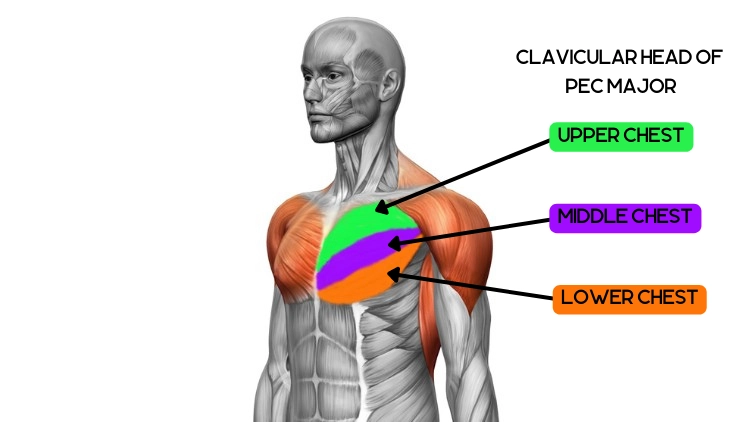
Source: Science Photo Library via Canva.com16
Jump Rope Benefits
New jumpers are also often curious about the many benefits that jumping rope has to offer. There are many pros to adding this exercise to a workout regime.

Source: MART PRODUCTION from Pexels17
Check out the benefits below for a detailed explanation of why jumping rope is great for overall health and fitness.
Weight Loss
If beginners wants to jump start their weight loss journey, one effective was is to get more active. And what better way than jumping rope! Jumping rope burns a lot of calories because it requires a lot of energy from the body to perform.
Burning more calories will aid dieters in creating a larger caloric deficit, which simply means burning more calories than one consumes. A larger caloric deficit will lead to more weight loss.
So if shedding unwanted pounds is the goal, then adding in the jump rope is a great way to facilitate the burning of calories.
Furthermore, research has found significant decreases in body fat percentage and waist circumference size for participants in a 12 week jump rope program.18 So not only does jumping rope help dieters to lose weight, but it also helps knock off hard to lose fat too!
Muscle Building
As detailed above, the jump rope works a significant amount of muscle groups. This can lead to improving muscular size and strength, without a bulky appearance.
For those aiming to maximize muscle growth, incorporating jump rope alongside a 6-week powerlifting program can significantly boost results.
Research has documented that muscle weakness is maximized on day three of high intensity exercise, so jumpers should make sure to take an off day every so often to allow the muscles time to rest.19 This prevents injury and prolonged muscle fatigue.
Cardiovascular Endurance
Jumping rope is a great workout for burning fat and building muscle. But in addition to these benefits, it’s also an excellent cardiovascular workout.
Jumping rope helps to improve endurance, overall fitness level, and heart health too.
Improved Coordination & Balance
Jumping rope is a dynamic exercise, meaning that it requires a lot of focused movement to complete. When engaging in this exercise, a person’s coordination and balance will be challenged, leading to improvements in these areas with consistent work.
In fact, research even shows that jumping rope significantly improved motor coordination.20 Jumpers shouldn’t worry if they mess up when first starting out.
Remember, practice makes perfect.
Is Jump Rope Good for Weight Loss?
Dieters everywhere who enjoy jump rope might be wondering if jump rope is good for weight loss. Lucky for them, the answer is yes!
Jump rope can be a great way to help unwanted weight. This activity is a high-intensity cardiovascular exercise that can help to burn a significant number of calories in a short amount of time.
Along with aiding in shedding hard to lose pounds, jumping rope can also help improve overall coordination and stability, and also strengthen the engaged muscles. This will lead to an overall more toned appearance as a person burns fat and also gains muscle.
In order to lose weight, it is important to create a caloric deficit. This is achieved by burning more calories than one consumes.
Jumping rope can help to create a larger caloric deficit by burning more calories, but to maximize weight loss results dieters are recommended to eat a healthy diet that is full of fruits, vegetables, whole grains, and lean protein.
Does Jump Rope Build Muscle?
Considering what muscles does jumping rope work detailed above, this activity can help to build muscle. Especially in the lower body.
The repetitive motion of jumping during jump rope requires the use of all the muscles in the legs, as well as the muscles in the core, and some muscles of the upper body too.
In addition, jumping rope can also be a form of high intensity interval training, otherwise known as a HIIT workout. This technique involves short bursts of highly intense exercise followed by a break period.
Studies have shown that HIIT workouts are effective for muscular hypertrophy, meaning increased muscle size and strength. Those who include jumping rope in their workout routine, especially high intensity interval training jump rope programs, are likely to find increased muscle building and improved overall physical fitness levels.
Those looking to add muscle mass should know that adequate protein supports muscle building and improves recovery time. Alongside jumping rope, a fitness enthusiast might consider incorporating a protein shakes diet plan to support muscle growth and maintenance.
Is Jump Rope a Good Cardio?
It’s been established that jumping rope can help to build muscle and lose weight. In addition to that, jumping rope is also a good form of cardio!

Source: Yaroslav Shuraev from Pexels21
The jump rope can be a great form of cardiovascular exercise, and can be used to help improve overall cardiovascular fitness as well as endurance.
This works by challenging the vital heart and lungs to deliver adequate oxygen to the muscles of the body.
In order to get the most cardiovascular benefits from the jump rope, jumpers should aim to keep up a baseline of moderate intensity for roughly 20 to 40 minutes. Studies show this amount of time for aerobic, or oxygen requiring cardio, is best paired with the frequency of 3 to 5 days per week for maximized health outcomes such as a lower risk of disease and stroke.22
One Month Jump Rope Before & After Pictures + My Jump Rope Results & Experience
Before and after photos and personal weight loss stories are some of the most motivating materials for those wanting to achieve their fitness goals. Check out the incredible results below of those who dedicated their time to jumping rope to improve their health and appearance.
Plus read about my personal experiences with jumping rope below for further insights about the exercise.
Ashley
Ashley had a full body transformation from jumping rope that she is proud to share with her youtube followers. She aimed to jump rope every single day for at least 30 days.
She made her goal feasible for a beginner jumper, with 1000 jumps completed per day. On her youtube channel she documents her thoughts and progress, and is proud to say that jumping rope has brought her to a new low weight.
Here’s a photo of her incredible results!
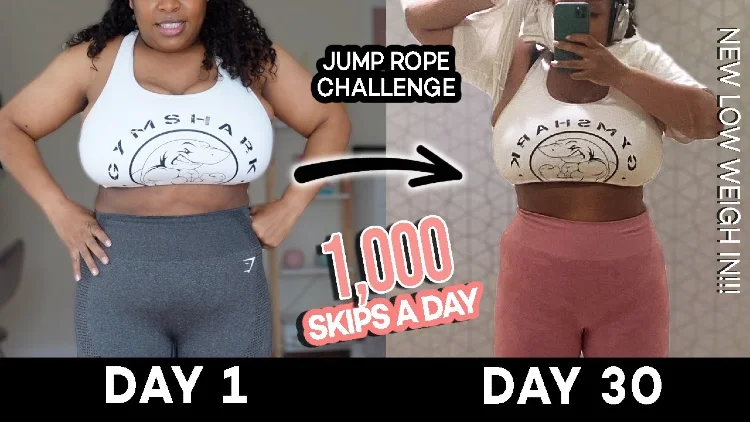
Ashley’s dedication to jumping rope for 30 days has paid off with amazing full body transformation. Source: Ashleysayque on Youtube23
Cam (Goal Guys)
This youtuber completed a similar 30 day jump roping challenge. But instead of doing 1000s jumps a day, he aimed to complete 30 minutes of jumping straight each day of the week.
As a result, this man lost about three pounds. More impressively, he dropped 0.3% in body fat percentage, which is a pretty impressive accomplishment to obtain within a month!
Here is his one month jump rope before and after pictures:

His dedication resulted in a remarkable body transformation, shedding three pounds and an impressive 0.3% body fat percentage. Source: Goal Guys on Youtube24
My Results
In all honesty, jumping rope has changed my life because it is such a fun activity that I look forward to every day.
In terms of health, I have seen drastic improvements in my cardiovascular fitness.
This means that doing things such as running distances or jumping for longer intervals has become much easier. I’ve even noticed this carrying over to my everyday life, as walking up flights of stairs without feeling out of breath.
It has also helped me to lose weight, and more importantly, burn fat. From building muscle and dropping in body fat percentage, my legs and butt have had a noticeably toned and lifted effect.
Readers who want more variation in workouts than what jumping rope can offer may be interested in Peloton classes instead. They offer a wide variety of programs that a person completes to help reach whatever fitness goals they might have.
The results of a Peloton before and after weight loss journey can be astounding!
Jump Rope Variations To Try & Their Benefits
It’s important to add variation to any exercise or fitness routine to help engage various muscle groups and to see greater results. Luckily, jumping rope has many different variations to choose from!
Jumpers can choose to concentrate solely on jumping rope or incorporate these variations into their 4 day workout split to maximize results.
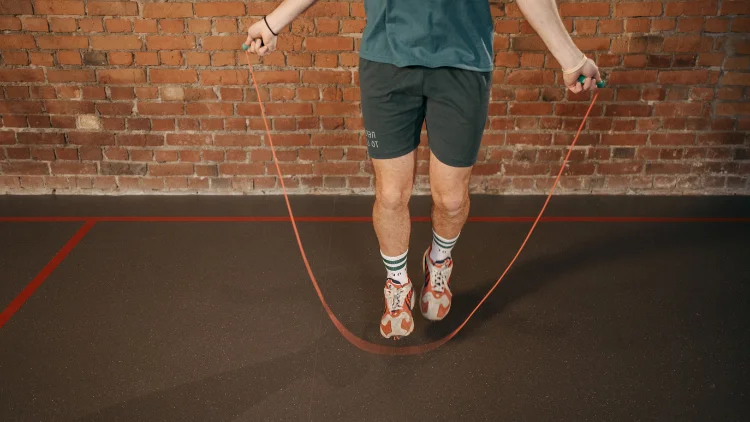
Source: Pavel Danilyuk from Pexels25
Check out the examples below for some jump rope movement variations that are easy to incorporate into any jumping routine. Or simply use a freestyle method of whatever feels best.
Studies have shown freestyle jumping can lead to higher improvements in muscle building and flexibility compared to the traditional jumping counterpart.6
One Legged Jump Rope
This variation will engage the same muscles as regular rope jumping, but ups the intensity. Because only one leg is supporting the body, it will also aid in the development of a person’s balance, stability, and overall coordination.
To do this exercise, simply switch from two legged jumping to one leg instead. Make sure to switch legs after a certain number of jumps or time period is completed.
High Knees Jump Rope
High knees is a great variation for those wanting to switch up their jump rope routine. It makes the exercise itself much more intense, and while the same muscles are engaged as regular jump rope, the hamstrings in the upper thigh will be more dominantly targeted.
This is a result of the full range of motion knee flexion movement required for the high knees position. To do a high knee jump, the jumper should bring their knees up towards your chest as much as possible.
Lateral or Side To Side Jumps With Rope
Lateral or side to side jumps on the jump rope will engage the hip abductors and adductors, which are the muscles that move the leg away and towards the body’s midline respectively. This in addition to the other muscles that a normal jump rope variation engages too.
To do a lateral jump with a jump rope, simply jump while moving side to side rather than jumping in place.
Jumping Jacks Jump Rope
This is a great jump rope variation to target the hip abductors and adductors, much like the exercise above. Because this requires a bit of fancy footwork, jumpers can expect to see improvements in coordination too.
To do this variation, jump with the feet wide apart and then bring them back together before jumping over the rope.
Jumping rope is not only fun, but a great exercise despite a person’s fitness expertise. When it comes to the muscles that work during jump rope, readers now know that the simple exercise can be used to engage nearly the entire body, producing incredible fitness benefits and results!
Frequently Asked Questions
What Does Jumping Rope Work On?
Jumping rope works on a number of different areas of fitness such as losing weight, burning hard to get rid of fat, and improving a person’s cardiovascular fitness for improved heart health. Finally, as detailed above, jumping rope can help to engage many muscle groups of the body, leading to increased muscle size and strength; it’s an exercise that truly works on just about everything.
How Often Can You Jump Rope?
Jump rope can be completed as often as a person would like, depending on the intensity of their jump rope workout. For example, those completing a HIIT or high intensity interval training type of jump rope workout should only do so a couple times per week while those using the jump rope for a low intensity workout can do so most days.
What Muscles Does Jump Rope Work When Done Backwards?
The answer to what muscles does the backwards jump rope work is the same as what muscle does jump rope work. Primarily, backwards jump roping will engage the muscles of the butt and legs, including the glutes, quads, hammies, and calves, but it will also engage some of the upper body as well, including the core, back, arm and forearm muscles.
References
1Pavel Danilyuk. “A Man Exercising with a Jump Rope.” Canva. Accessed 15 April 2023. <https://www.canva.com/photos/MAERzPgbnus-a-man-exercising-with-a-jump-rope/>
2decade3d. “Gluteus Maximus – Anatomy Muscles.” Canva. Accessed 12 April 2023. <https://www.canva.com/photos/MADerAJvWMU-gluteus-maximus-anatomy-muscles/>
3decade3d. “Glutes Medius – Anatomy Muscles.” Canva. Accessed 12 April 2023. <https://www.canva.com/photos/MAC_U4VEw9o-glutes-medius-anatomy-muscles/>
4“Quadriceps Female Anatomy – Photos by Canva.” Canva. Accessed 20 Apr. 2023. <https://www.canva.com/photos/MADE-Sq7uLk-quadriceps-female-anatomy/>
5decade3d. “Hamstrings – Anatomy Muscles.” Canva. Accessed 15 April 2023. <https://www.canva.com/photos/MADerMxdfBI-hamstrings-anatomy-muscles/>
6decade3d. “Abs – Anatomy Muscles.” Canva. Accessed 12 April 2023. <https://www.canva.com/photos/MADerFwn3js-abs-anatomy-muscles/>
7Lin, Y., Lu, Z., Cen, X., Thirupathi, A., Sun, D., & Gu, Y. (2022). The Influence of Different Rope Jumping Methods on Adolescents’ Lower Limb Biomechanics during the Ground-Contact Phase. Children (Basel, Switzerland), 9(5), 721. <https://doi.org/10.3390/children9050721>
8decade3d. “Calves – Anatomy Muscles.” Canva. Accessed 14 April 2023. <https://www.canva.com/photos/MAC_U2yFahk-calves-anatomy-muscles/>
9Hank Grebe. “Labeled Anatomy Chart of Neck and Shoulder Muscles on White Background.” Canva. Accessed 15 April 2023. <https://www.canva.com/photos/MADZASGJL7w-labeled-anatomy-chart-of-neck-and-shoulder-muscles-on-white-background/>
10Hank Grebe. “Labeled Anatomy Chart of Shoulder, Elbow and Triceps Muscles in Skeleton on Black Background.” Canva. Accessed 14 April 2023. <https://www.canva.com/photos/MAEJnzTxmJU-labeled-anatomy-chart-of-shoulder-elbow-and-triceps-muscles-in-skeleton-on-black-background/>
11Science Photo Library. “The muscles involved in standing biceps curl. The stabilizing muscles are highlighted.” Canva. Accessed 12 April 2023. <https://www.canva.com/photos/MADmTGwAFbo-the-muscles-involved-in-standing-biceps-curl-the-stabilizing-muscles-are-highlighted-/>
12Science Photo Library. “”Shoulder muscles.” Canva. Accessed 12 April 2023. <https://www.canva.com/photos/MADmTDg8VA4--shoulder-muscles/>
13“Muscles Forearm Anterior Posterior View Stock Illustration 147943889 | Shutterstock.” Shutterstock. Accessed 20 Apr. 2023. <https://www.shutterstock.com/image-illustration/muscles-forearm-anterior-posterior-view-147943889/>
14Science Photo Library. “F017/1255.” Canva, 20 April 2019. Accessed 13 April 2023. <https://www.canva.com/photos/MADq3vbyn-k-f017-1255/>
15Science Photo Library. “”Human trapezius muscles.” Canva. Accessed 13 April 2023. <https://www.canva.com/photos/MADmTLHptgU--human-trapezius-muscles/>
16Science Photo Library. “The muscles involved in standing biceps curl. The stabilizing muscles are highlighted.” Canva. Accessed 12 April 2023. <https://www.canva.com/photos/MADmTGwAFbo-the-muscles-involved-in-standing-biceps-curl-the-stabilizing-muscles-are-highlighted-/>
17MART PRODUCTION. “Woman exercising using Jumping Rope.” Canva. Accessed 15 April 2023. <https://www.canva.com/photos/MAEfd4FiBfI-woman-exercising-using-jumping-rope/>
18Kim, J., Son, W. M., Headid Iii, R. J., Pekas, E. J., Noble, J. M., & Park, S. Y. (2020). The effects of a 12-week jump rope exercise program on body composition, insulin sensitivity, and academic self-efficacy in obese adolescent girls. Journal of pediatric endocrinology & metabolism : JPEM, 33(1), 129–137. <https://doi.org/10.1515/jpem-2019-0327>
19Paoli, A., Gentil, P., Moro, T., Marcolin, G., & Bianco, A. (2017). Resistance Training with Single vs. Multi-joint Exercises at Equal Total Load Volume: Effects on Body Composition, Cardiorespiratory Fitness, and Muscle Strength. Frontiers in physiology, 8, 1105. <https://doi.org/10.3389/fphys.2017.01105>
20Trecroci, A., Cavaggioni, L., Caccia, R., & Alberti, G. (2015). Jump Rope Training: Balance and Motor Coordination in Preadolescent Soccer Players. Journal of sports science & medicine, 14(4), 792–798. <https://pubmed.ncbi.nlm.nih.gov/26664276/>
21Yaroslav Shuraev. “Woman in White Tank Top and Black Leggings Holding Walking Stick.” Canva. Accessed 15 April 2023. <https://www.canva.com/photos/MAEiU-kzM48-woman-in-white-tank-top-and-black-leggings-holding-jump-rope/>
22Pang, M. Y., Charlesworth, S. A., Lau, R. W., & Chung, R. C. (2013). Using aerobic exercise to improve health outcomes and quality of life in stroke: evidence-based exercise prescription recommendations. Cerebrovascular diseases (Basel, Switzerland), 35(1), 7–22. <https://doi.org/10.1159/000346075>
23Ashleysayque. “Jump Rope Workout Transformation (1000 Jumps) For +30 Days | FAT BURNING Plus Size Fitness.” YouTube, 26 September 2022, Accessed 31 March 2023. <https://www.youtube.com/watch?v=LL4-d1N2Cm0>
24Goal Guys. “I did 30 Minutes of Jump Rope Every Day for 30 Days.” YouTube, 10 May 2017, Accessed 31 March 2023. <https://www.youtube.com/watch?v=1zT2l41CAFQ&t=748s>
25Pavel Danilyuk. “Person Doing Jump Rope.” Canva. Accessed 15 April 2023. <https://www.canva.com/photos/MAERzNXh1q8-person-doing-jump-rope/>
26Yang, X., Lee, J., Gu, X., Zhang, X., & Zhang, T. (2020). Physical Fitness Promotion among Adolescents: Effects of a Jump Rope-Based Physical Activity Afterschool Program. Children (Basel, Switzerland), 7(8), 95. <https://doi.org/10.3390/children7080095>